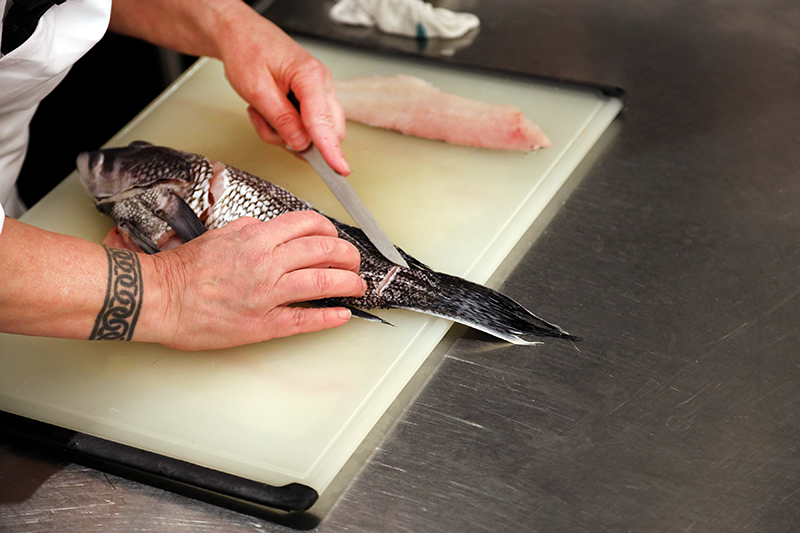Sharp kitchen knives are essential to your culinary toolkit, but much more goes into choosing the right knife than blade style and sharpness alone. Depending on the ingredients you're preparing, you'll want to choose the one that's best suited to the task at hand. At the Institute of Culinary Education, knife skills are a primary part of the training experience at our campuses in New York and Los Angeles and in our Online Culinary Arts program. Here, we'll discuss some of the top things to consider when choosing a knife and list some of the most popular styles used in restaurants.
What Are the Parts of a Knife? Know Your Knife Anatomy
First, it's important to learn some of the key terminologies. The average knife is made up of several parts, and each piece of the puzzle contributes to the overall performance and comfort of this kitchen tool. From tip to tang, here's a quick knife guide:
- Tip: Forward-most portion of the blade
- Edge: Cutting side of the blade
- Spine: Back side of the blade, opposite the edge
- Handle: Gripping part of the knife
- Bolster: Thick band of material between the blade and handle that helps protect your hand
- Tang: Part of the blade that extends into the handle
In terms of design, many knives are crafted from a combination of stainless steel and carbon steel, while the handles range from plastic to wooden. Many knives also have contoured or ergonomic handles for better gripping power. While shopping, see if you can grip the handle in the store to get a sense of how comfortable the knife will be in the kitchen.

Types of Kitchen Knives & Their Uses
Whether it's finely chopping herbs or slicing thick cuts of meat, the knife you choose makes all the difference in your meal prep time and results. As part of the Institute of Culinary Education student experience, you'll be taught which knives work best in different situations. Here is a list of some of the most commonly used knives in a professional kitchen:
- Paring knife: This small knife has a short blade that tapers at the end and often is used to peel and slice soft fruits and vegetables. It also works well for precision cutting, mincing and dicing tasks.
- Chef's knife: One of the most versatile tools in the kitchen, the chef's knife has a broad, sharp blade that's perfect for a wide variety of tasks.
- Serrated knife: With saw-like teeth down the blade, chefs often reach for the serrated knife when greater stability is needed. It firmly grips delicate skins (like tomatoes), and works well on light, flaky pastries and crusty breads.
- Utility knife: Sized just between the paring and chef's knives, the utility knife (or sandwich knife) is a staple when cooking. It comes in either straight or serrated edges and can be used on meat, herbs, vegetables and bread.
- Fillet knife: Thin and more flexible than the chef’s knife, this knife suits more delicate tasks, such as removing the scales from a fish.
- Boning knife: Simply put, this knife is used to separate bone from meat. The blade usually is flat and slightly curved with a sharp tip at the end, which is ideal for precision cuts.
- Cleaver: Also called a butcher's knife, the cleaver has a thick blade with a beveled edge. This knife is ideal for meat, thick vegetables and other ingredients.
- Pastry knife: This knife has a long, serrated blade that ends in a rounded tip. It's ideal for cutting baked pastry crust, lifting rolled pastry from a board and removing cakes from baking pans.
Teaching Essential Culinary Arts Skills
Knife skills are a fundamental part of our curriculum — find your culinary voice at the award-winning Institute of Culinary Education. From how to choose the ideal knife to techniques for achieving your desired results, students are trained to use their tools effectively by knowledgeable chef-instructors with a diverse range of experience in their respective fields.
We pride ourselves on a well-rounded curriculum that goes beyond basic kitchen skills and covers the business side of the industry, as well. Our campuses are in New York City and Los Angeles, and our online Culinary Arts & Food Operations diploma program is available to students in select locations throughout the country: California, Connecticut, New Jersey, Pennsylvania, North Carolina, Texas, Arizona, Michigan, Ohio, Idaho, Tennessee, Virginia, Wyoming and Hawaii. For more information about our culinary externships or culinary arts programs, request info today.




